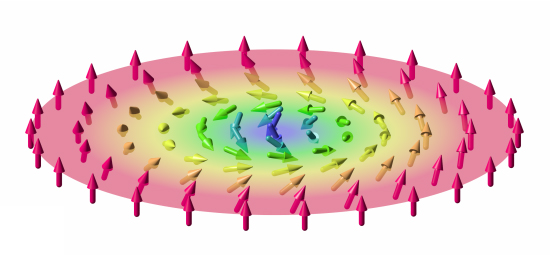AU researchers to build skyrmion sensor with terahertz technology
A new research project at Aarhus University could be the determining factor for the computer technology of the future. The project aims to develop a sensor that can read so-called skyrmions. These are extremely small magnetic 'tornadoes', which may well be a vital storage medium in the future.

A team of researchers at Aarhus University has received DKK 2.8 million from Independent Research Fund Denmark, IRFD, to develop an optical sensor to decode the direction of a skyrmion swirl: Incredibly small, stable swirls in magnetic materials created by electrons rotating around themselves.
The direction of the swirl of these tiny nano-sized tornadoes can represent binary code – 0 and 1 depending on the swirl's direction – and skyrmions are therefore being touted as promising candidate bits in the computer technology of the future.
"Today we store data as binary code on magnetic layers in hard drives. However, skyrmions require far less power and generate far less heat compared to reading and writing ferromagnetic domains, as we do today when our computers store data in 0s and 1s," says Assistant Professor Pernille Klarskov Pedersen, the project manager from the Department of Electrical and Computer Engineering at Aarhus University.
Far greater data density
Internet traffic has increased a thousand-fold since 2000, and currently accounts for about 10 per cent of the world's electricity consumption. This traffic will only increase, and the need for new, energy-saving technologies that can read and write data is therefore enormous.
Skyrmions are named after the British physicist Tony Hilton Royle Skyrme, who first suggested their existence in 1961. In the 1990s, Skyrme's model became interesting for electronic systems, but not until the past decade have skyrmions been realised and gained interest as storage technology.

Magnetic skyrmions could be the storage medium of the future. It however requires new technology to measure them competitively. Photo: Wikimedia Commons, Karin Everschor-Sitte & Matthias Sitte.
Skyrmions are down to 1 nm in size and are topologically stable. In other words, their spin direction does not change once it has been formed, no matter how closely you pack information. This is a huge advantage over today's magnetic domains, which are unstable when they are too densely packed.
Furthermore, skyrmions are far less energy-consuming to write than today's binary code.
Overall, this means that skyrmion-based storage units can be far smaller than today's, and they can hold significantly greater data density, while at the same time generating far less heat and requiring far less power.
Potentially ground-breaking
It all sounds very good, but the problem with skyrmions today is that they are very difficult to measure and read. You can write them and change them, but not yet measure them competitively. There are only a few methods, based on physical probes, and the measurements usually have to be carried out under isolated conditions due to the probes' sensitivity. This makes it extremely expensive to read information, and therefore skyrmions cannot yet be used as storage media.
This is where Pernille Klarskov Pedersen and her project come into the picture.
"On the basis of a new study predicting that skyrmions can oscillate at terahertz frequencies, we will develop an optical sensor based on terahertz light. An optical sensor will provide a wide range of advantages, including flexibility, robustness and the ability to detect with the speed of the light," she says, and continues:
"We’re now starting gently with structured materials, i.e. materials designed to have skyrmions, and then we’ll have to see what’s possible. But if it turns out that we can actually measure skyrmions with terahertz light, it will be ground-breaking for all computer technology in the future. We’ve set ourselves a huge challenge here, but the goal is really worth it."
Pernille Klarskov Pedersen's project, OpSky, has received a grant of DKK 2.8 million from Independent Research Fund Denmark (IRFD). The project officially starts on 1 October and it will run for three years.
Contact
Assistant Professor Pernille Klarskov Pedersen
Mail: klarskov@ece.au.dk
Tel.: +45 93521158
